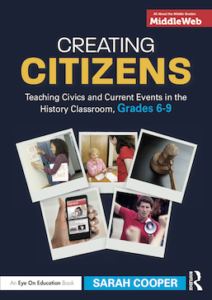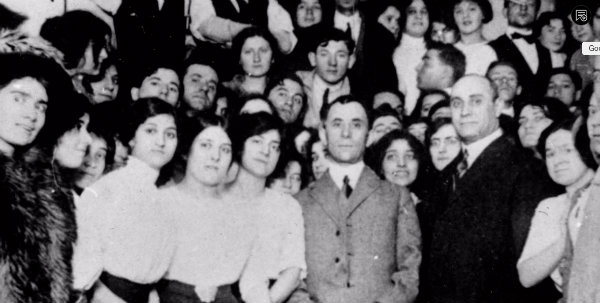On the Best Days, Our Students Teach Us
A MiddleWeb Blog
 This week it has been even more of a pleasure than usual to spend time with eighth graders. They’ve been creating social reform concept maps, an oldie-but-goodie project that I pull out once in a while for a quick and differentiated unit recap.
This week it has been even more of a pleasure than usual to spend time with eighth graders. They’ve been creating social reform concept maps, an oldie-but-goodie project that I pull out once in a while for a quick and differentiated unit recap.
While I play classical guitar music from YouTube, they list history facts that might connect to each other, with creative titles such as Alec’s “Becoming an Upstander” and Hope’s “The Power of Miss-Behaving.” They spread out, on the floor and across their desks, choosing colored pencils that add emphasis to a quotation such as Frederick Douglass’ “Right is of no sex.”
Yet this miniproject, two or three days’ worth, feels not like the culmination of our unit but rather like the icing on the cake. Why? Because the students have taught me during lessons when I had anticipated teaching them.
As I approached this year’s thematic unit on social reform throughout U.S. history, a cornerstone of my U.S. history curriculum, I knew I wanted to infuse new life into it in at least four ways:
- Make the themes more explicit. After a number of years of adding and subtracting sources, I had lost a through line. I decided to focus on women’s history as a case study, while also bringing in complementary movements, such as abolition and temperance.
- Highlight photos. I felt that the unit had become dry and text-heavy. This year, portraits of Ida Wells-Barnett and Elizabeth Cady Stanton, as well as Jacob Riis’ scenes of tenements, humanized these activists.
- Intertwine songs and videos. To spark kids’ interest beyond photographs, I wanted to include at least one song (Bread and Roses, above, from the Progressive labor movement) and also a number of short video clips about the Seneca Falls Convention, the Triangle Shirtwaist Fire, The Feminine Mystique, and the HeforShe movement.
- Mix up reading responses. I wanted students to engage actively with the textbook material in class each day, rather than listening to me go over key terms and ideas. One day they worked in groups to pull out vocabulary words about a certain issue, such as child labor or food safety, and another day they paired off to list key terms and names relating to mid-19th century abolition and women’s suffrage.
All of these minor rehabs felt like paint touch-ups rather than new drywall, and they didn’t require much time. Yet the renovation made the two-week unit feel more substantial, no longer disconnected or inert. Each day we engaged with a variety of sources, had a healthy mix of partner work and all-class discussion and asked questions that hinted at larger issues underlying social reform.
Owners Max Blanck and Isaac Harris with Triangle Shirtwaist Factory workers. Months after striking for better pay and working conditions with limited success, 146 workers (123 of them women) died as locked doors kept them from escaping the burning factory building.
Watching students make fresh connections
What surprised me, though, was how much showcasing these new sources and activities – ones I didn’t know everything about, ones I hadn’t taught over and over – put the work of connecting the dots into students’ hands.
Often I knew I was aiming for a general theme, but I didn’t yet have the historical “punchlines” at the ready. Instead, the students supplied them.
For instance, one day I asked the eighth graders to compare and contrast the women’s movement of the 1910s and ’20s with that of the 1960s and ’70s, based on the text reading they had done the night before. In pairs, they made charts with two similarities and two differences, adding a fact or quote to support each.
When we put the ideas on the board, Ellen raised her hand and said that the two columns reminded her of the “Bread and Roses” song we had heard earlier that week.
“It seems that the earlier women’s movement was fighting for ‘bread,’ or basic rights such as voting, and the later women’s movement was fighting for ‘roses,’ or less fundamental rights, such as the Equal Rights Amendment,” Ellen said.
Sean went on to say, “I respectfully disagree. ALL of these rights, whether basic or less basic, are ‘bread,’ because any right is important.”
In all my years of teaching “Bread and Roses,” I had never thought to apply its dichotomy to individual rights in history.
We went on to talk about whether the ERA represented fundamental rights or “luxury” rights. This topic led me to think about Abraham Maslow’s hierarchy of needs, so I projected an image of his pyramid, with its five rising levels: physiological needs, safety needs, love and belonging, esteem, and self-actualization.
“It’s interesting that reproduction is on the bottom, with physiological needs,” Dri observed. Having just read about Roe v. Wade, she said she would classify control over one’s own reproduction as higher up, in the “esteem” level. A few others agreed.
The bell rang as the discussion took off, and I walked out marveling.
Had I tried to plan a lesson on “bread versus roses” in reform movements, it might have flopped out of sheer didacticism. But giving students room to make their own connections meant that they could teach me.
It’s like adding yeast to flour, or fizz to water. You know it’s going to be delicious, but you’re not quite sure how.
________________________________________________________________________________
 Sarah Cooper’s timely new book, Creating Citizens: Teaching Civics and Current Events in the History Classroom, Grades 6–9, is a Routledge/MiddleWeb publication. MiddleWeb readers receive a 20% discount from Routledge with the code MWEB1.
Sarah Cooper’s timely new book, Creating Citizens: Teaching Civics and Current Events in the History Classroom, Grades 6–9, is a Routledge/MiddleWeb publication. MiddleWeb readers receive a 20% discount from Routledge with the code MWEB1.

































